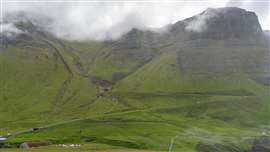Read this article in Français Deutsch Italiano Português Español
EFCA: Engineering solutions in the Faroe Islands – the contrast of the traditional and the modern
25 November 2024
EFCA highlights a recent visit to the Faroe Islands and the latest on the underwater tunnels that are currently being built.

Situated roughly in the middle of an invisible upside down triangle, at the points of which can be found Iceland, Norway and Scotland, are the remote, beautiful and welcoming Faroe Islands.
Recently, the Nordic associations representing consulting engineers at national level, held their annual meeting there. As well as sharing national updates, the representatives from Denmark, Finland, Iceland, Norway and Sweden also discussed EU matters with EFCA. The Chairman of the board of local firm SMJ Consulting Engineers was also present and offered convivial hospitality; along with representatives of other Faroese and Nordic firms.
With a relatively harsh climate added to the remote location, the construction industry needs unique solutions and these are provided with a mix of traditional and modern methods that, although designed for local needs, could be used elsewhere. Some jaw-dropping ambitious projects inspired EFCA to give the spotlight this month to construction and engineering in the Faroe Islands.
Eysturoyartunnilin
At around 190M below the sea and over 11km long, the Eysturoy Tunnel was completed in 2020. Never likely to be blocked by traffic jams, the tunnel is dark, eerily calm and decorated here and there by art, which adds some colour to the mainly black rock interior. The project was a partnership between the lead consulting engineer Norconsult, lead contractor NCC and local firms SMJ and LBF. After visiting one of the pump “rooms”, the group’s minibus went twice round the world’s first under-sea roundabout, adding a moment of pure fun to an awe-inspiring and educational technical tour. More information about the tunnel, as well as other aspects of the Faroe Islands, can be found online. For readers wanting more photos and technical information, Norconsult’s relevant website offers a good overview.
Revolutionising tidal energy with dragons
EFCA published its position paper on water (the “Blue Deal”) in January this year and whilst researching for the paper, discussed with experts the potential and challenges of tidal power. Notoriously expensive and difficult to maintain, traditional ocean turbines, whilst still offering a reliable source of renewable energy, are putting off researchers, engineering firms, investors and policy makers alike, because of the difficulties of scaling up and the cost-benefit dilemma. An alternative method is being tested, albeit with a lot more to do, to optimise the potential of the technology.
Is it a kite, is it a plane? A new kind of turbine, bright yellow and attached to the seabed by a cable, travels through the water at some speed, generating energy as it moves. This can then be transmitted to land via cables. The renewable energy company Minesto has been testing these futuristic machines in the sea off the Faroe Islands.

The kite-shaped turbines are called “dragons”. Amongst the disadvantages that still need to be overcome, is the potential for collision, including with wildlife, such as whales. Even if and when solved, at the moment it seems unlikely that dragons will become the preferred renewable energy source in the very near future. Nevertheless, the technology is impressive, and another example of the surprising innovation found in and around the islands.
Hairy roofs
From the modern to the traditional, no article on engineering in the Faroe Islands would be complete without a mention of the energy-efficient, nature-based and seriously cute turf roofs, seen on many buildings, including newer ones, on every street in the towns and in the more remote villages. Green in the summer and a more muted colour in the winter, these roofs have become a tourist attraction and as a symbol of the rugged beauty of the Faroes, you don’t get much more “picture-postcard” than this. What is striking though, is the efficiency of this very traditional method, which epitomises the nature-based solutions that we are all seeking in Europe. Spending an evening in such a building during the recent trip, when the weather outside was cold and blustery, the interior was surprisingly warm and cosy.
It would probably be naïve to conclude that this is the way forward for all big cities in the EU, or that this method can finally deliver energy efficiency and climate resistance, through a renovation programme that uses something so “mundane” and available as turf. Still, there are surely lessons to be learned. As we battle with the failing building renovation roll-out required to deliver the Buildings Directive (aka Energy Performance in Buildings Directive), maybe we are missing a trick, assuming that the solution is only found in modern technology.
STAY CONNECTED


Receive the information you need when you need it through our world-leading magazines, newsletters and daily briefings.
CONNECT WITH THE TEAM











